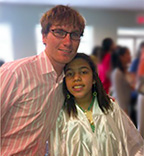What is secondary transition and why is it important for students with disabilities?
Page 2: The Importance of Secondary Transition Planning

Living more independently is a goal for many students as they make the transition from high school to post-school programs or environments. Many look forward to starting a new job, whereas others anticipate entering a college or university. However, current research indicates that students with disabilities do not necessarily enjoy the same chances of achieving those goals as do their non-disabled peers.
Research Shows
- The National Longitudinal Study-2 (NLTS-2) data indicate that:
- 19% of students with disabilities attended four-year colleges and universities, compared to 40% of students without disabilities. Students with disabilities are more likely to attend two-year colleges or vocational schools.
- 35% of students with disabilities who enter four-year colleges and receive disability services from the college graduate, whereas 55% of students without disabilities graduate.
- Students with disabilities continue to demonstrate poorer employment outcomes than do other young adults (e.g., fewer hours per week, lower salaries, reduced benefits).
(Newman et al., 2011)
- More young adults with disabilities live with their parents, relatives, or legal guardians after high school than is the case for youth without disabilities.
(Newman et al., 2009; Wagner et al., 2005) - Young adults with disabilities lag behind their peers without disabilities in life-skills areas like managing household responsibilities and obtaining a driver’s license.
(Newman et al., 2009; Wagner et al., 2005)
Post-secondary transition planning has been successful in closing some of these gaps and has helped some students with disabilities to fulfill their post-school roles in the areas of work, living, and community. The result has been a number of improvements in post-school outcomes (e.g., employment rates, enrollment in post-secondary schools) for youth with disabilities.
Jim Martin, a national expert on student involvement in transition planning, discusses the importance of transition planning for all students and the need for this type of planning to be incorporated into the general education classroom (time: 1:37).

Jim Martin, PhD
Director, Zarrow Center
Department of Educational Psychology
University of Oklahoma
Transcript: Jim Martin, PhD
Many students have a difficult time transitioning from high school to life after high school. Just look at college students and the trouble so many students have in deciding upon a major. Transition education doesn’t mean that you will do what you end up thinking you’ll do when you’re in high school. But it teaches a process and a thinking process and a way to set goals and to evaluate your strengths and look at your skills and your supports to be able to figure out what you want to do. Those are skills that all students need, and many students don’t have those, students with and without disabilities. So in terms of general educators knowing about transition education, it’s something that I think is essential to secondary education because that’s where most students with IEPs spend the biggest portion of their time. So the career-development efforts, the efforts to teach self-determination skills, it can’t just be reserved for students with disabilities, because those strategies and tools are so successful that it needs to reach out and touch all students. I hope in the future that a major part of what special ed. can do, both within the public schools and in higher ed., is to help general educators understand basic transition education concepts so it can be infused into the content that they teach.
For Your Information
Federal laws support the need for all students, including those with disabilities, to be college or career ready:
- The Individuals with Disabilities Education Act: One purpose of this act, reauthorized in 2004, is to “prepare (students) for further education, employment and independent living.”
- The Higher Education Opportunities Act: The reauthorization of this act in 2008 opened the door to postsecondary education for students with intellectual disabilities, including those with significant cognitive disabilities participating in state alternate assessments.
Additionally, the Common Core State Standards reflect an effort by states to create shared academic standards and to establish clear and consistent learning goals that will prepare all children for success in college and work.